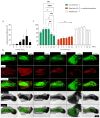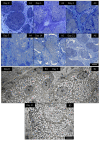A New Organotypic 3D Slice Culture of Mouse Meibomian Glands Reveals Impact of Melanocortins
- PMID: 36499274
- PMCID: PMC9737810
- DOI: 10.3390/ijms232314947
A New Organotypic 3D Slice Culture of Mouse Meibomian Glands Reveals Impact of Melanocortins
Abstract
The meibomian glands (MGs) within the eyelids produce a lipid-rich secretion that forms the superficial layer of the tear film. Meibomian gland dysfunction (MGD) results in excessive evaporation of the tear film, which is the leading cause of dry eye disease (DED). To develop a research model similar to the physiological situation of MGs, we established a new 3D organotypic slice culture (OSC) of mouse MGs (mMGs) and investigated the effects of melanocortins on exocrine secretion. Tissue viability, lipid production and morphological changes were analyzed during a 21-day cultivation period. Subsequently, the effects on lipid production and gene expression were examined after stimulation with a melanocortin receptor (MCR) agonist, α-melanocyte-stimulating hormone (α-MSH), and/or an MCR antagonist, JNJ-10229570. The cultivation of mMGs OSCs was possible without impairment for at least seven days. Stimulation with the MCR agonists induced lipid production in a dose-dependent manner, whereas this effect was tapered with the simultaneous incubation of the MCR antagonist. The new 3D OSC model is a promising approach to study the (patho-) physiological properties of MG/MGD while reducing animal studies. Therefore, it may accelerate the search for new treatments for MGD/DED and lead to new insights, such as that melanocortins likely stimulate meibum production.
Keywords: 3D cell culture model; dry eye disease; meibomian gland; meibomian gland dysfunction; melanocortin receptor; organotypic slice culture; vibratome; α-MSH.
Conflict of interest statement
The authors declare that they have no conflict of interest.
Figures






Similar articles
-
Alpha- and beta-melanocyte stimulating hormone positively impact lipogenesis of meibomian gland cells in vitro and ex vivo.Biomed Pharmacother. 2025 Apr;185:117937. doi: 10.1016/j.biopha.2025.117937. Epub 2025 Mar 2. Biomed Pharmacother. 2025. PMID: 40031375
-
Organotypic culture model of mouse meibomian gland as a screening platform for risk factors related to meibomian gland dysfunction.Ocul Surf. 2023 Oct;30:73-84. doi: 10.1016/j.jtos.2023.08.007. Epub 2023 Aug 22. Ocul Surf. 2023. PMID: 37619669
-
Human precorneal tear film and lipid layer dynamics in meibomian gland dysfunction.Ocul Surf. 2021 Jul;21:250-256. doi: 10.1016/j.jtos.2021.03.006. Epub 2021 Mar 23. Ocul Surf. 2021. PMID: 33771707 Free PMC article.
-
New Insights Into the Lipid Layer of the Tear Film and Meibomian Glands.Eye Contact Lens. 2017 Nov;43(6):335-339. doi: 10.1097/ICL.0000000000000369. Eye Contact Lens. 2017. PMID: 28410282 Review.
-
[The role of meibum proteins in the pathogenesis of meibomian gland dysfunction].Vestn Oftalmol. 2025;141(1):70-75. doi: 10.17116/oftalma202514101170. Vestn Oftalmol. 2025. PMID: 40047025 Review. Russian.
Cited by
-
Culture of vibrating microtome tissue slices as a 3D model in biomedical research.J Biol Eng. 2023 Jun 1;17(1):36. doi: 10.1186/s13036-023-00357-5. J Biol Eng. 2023. PMID: 37264444 Free PMC article. Review.
References
-
- Jester J.V., Nicolaides N., Smith R.E. Meibomian gland studies: Histologic and ultrastructural investigations. Investig. Ophthalmol. Vis. Sci. 1981;20:537–547. - PubMed
-
- Knop E., Knop N., Millar T., Obata H., Sullivan D.A. The international workshop on meibomian gland dysfunction: Report of the subcommittee on anatomy, physiology, and pathophysiology of the meibomian gland. Investig. Ophthalmol. Vis. Sci. 2011;52:1938–1978. doi: 10.1167/iovs.10-6997c. - DOI - PMC - PubMed
MeSH terms
Substances
Grants and funding
LinkOut - more resources
Full Text Sources

